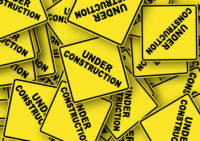The value of new construction starts dropped 2% in January to a seasonally adjusted annual rate of $402.2 billion, according to McGraw-Hill Construction, a division of The McGraw-Hill Cos. Both nonresidential building and housing settled back from December, while the nonbuilding construction sector managed to register a modest gain with the help of a rebound for new electric utility starts.
On an unadjusted basis, total construction starts in January were reported at $27.0 billion, down 14% from the same month a year ago. For the 12 months ending January 2012 versus the 12 months ending January 2011, which lessens the volatility present in one-month comparisons, total construction starts were down 3%.
The January statistics lowered the Dodge Index to 85 (2000=100), compared to December’s reading of 87. Over the course of 2011, the Dodge Index moved within the range of 81 to 101, with the average for last year coming in at 90.
“For construction starts, the year 2012 got off slowly, with activity retreating further into the lower half of its recent range,” stated Robert A. Murray, vice president of economic affairs for McGraw-Hill Construction. “This is consistent with the view that construction is still struggling to achieve upward momentum, even with the recent improvement shown by the U.S. economy. There were some positive signs for construction during 2011, such as a stronger volume for multifamily housing, a record high for new electric utility starts, and even gains for a few commercial structure types (hotels and warehouses). However, these positives were offset by declines for single family housing, public works, and institutional building. For 2012, both public works and institutional building will continue to be affected by diminished federal funding, as well as by tight state and local budgets.
“Single-family housing may draw some benefit from the recent federal-state agreement with major banks to rework troubled mortgages, but homebuyer demand will still be restrained by more stringent bank lending standards, which limits any construction upturn. While multifamily housing appears on the upswing and commercial building seems to be turning the corner, both will require more available bank financing. There were some signs that this was taking place during the first half of 2011, before concerns about the debt crisis in Europe during the second half of 2011 caused banks to adopt a more wait-and see approach.”
Nonresidential Building
Nonresidential building in January slipped 1% to $139.9 billion (annual rate). On the institutional side, weaker activity was reported for most of the structure types. The educational building category, which fell 12% during 2011, dropped 3% in January relative to the previous month. There were several noteworthy education-related projects that reached groundbreaking in January, including three research and laboratory facilities in these locations—Baltimore ($144 million), Boston ($93 million), and Berkeley, Calif. ($86 million)—but they were not enough to offset the downward trend for this category.
In similar fashion, the public buildings category in January included the start of a large courthouse in San Bernardino, Calif. ($272 million) and a large detention facility in Detroit ($220 million), but contracting for the month was still down 23%. Amusement-related projects and churches in January were each down 6%, while transportation terminal work dropped 36%. The one institutional structure type that registered a January gain was health-care facilities, which soared 105% due to the start of a $583-million replacement hospital in Denver.
On the commercial side, the recent upward trend for hotels and warehouses paused in January, with hotels down 16% and warehouses down 11%. The decline for hotels came despite the start of a $180-million resort hotel in Lake Buena Vista, Fla., and an $87-million addition to a convention center hotel in Chicago.
Store construction in January was able to move up 12% from its depressed December amount, and office construction advanced 20%, with support coming from the January start of a $113-million office building in Cambridge, Mass., and an $85-million data center in West Des Moines. The manufacturing plant category in January plunged 39%, sliding back from the improved activity that was reported during the fourth quarter of last year.
Residential Construction



Post a comment to this article
Report Abusive Comment